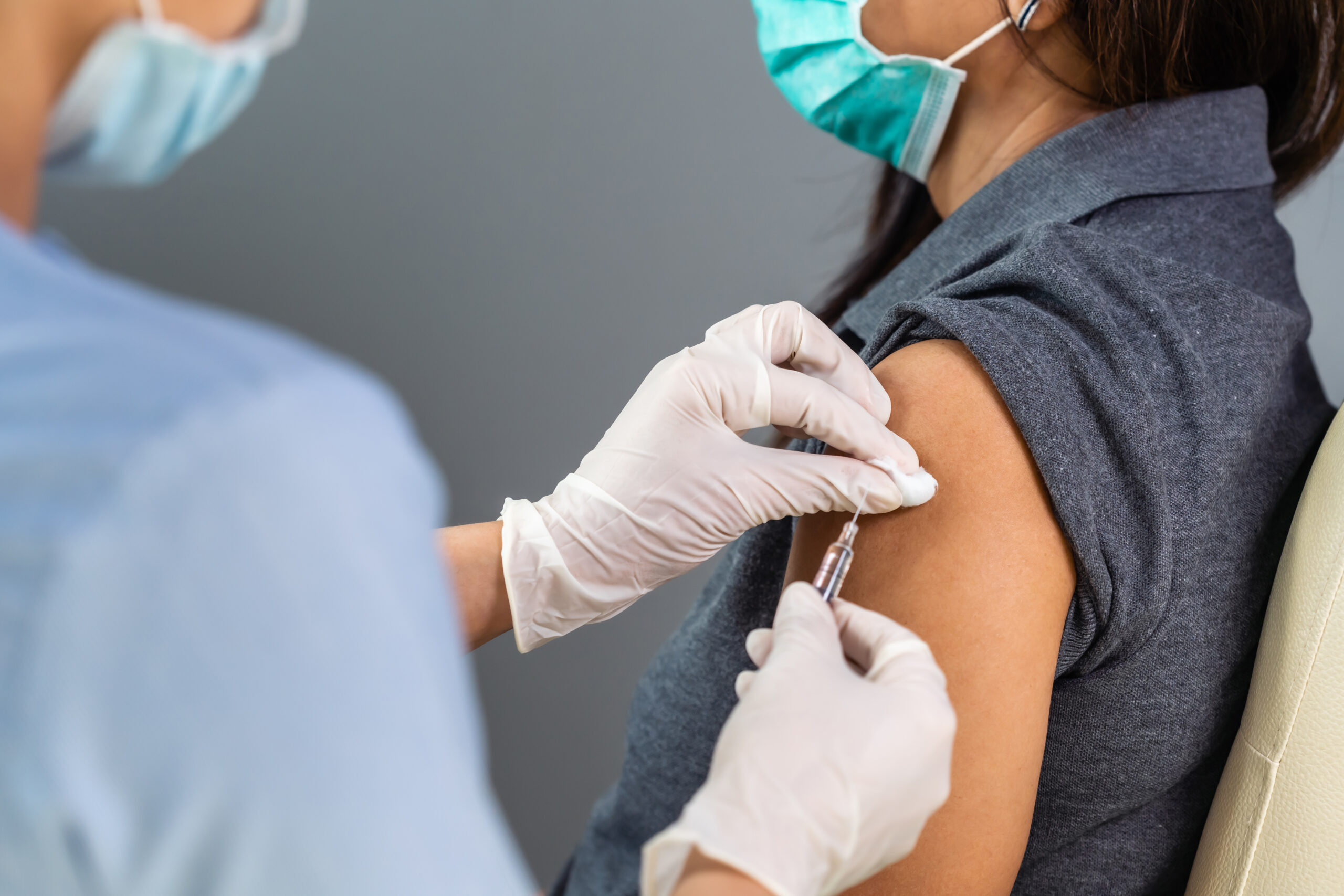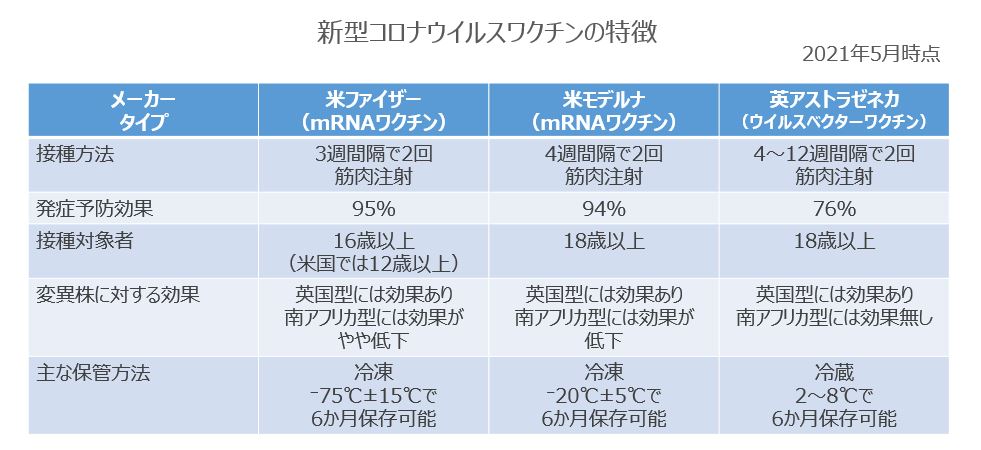ASOURCE®NAVI

公開日:2021.05.24
米・モデルナと英・アストラゼネカが開発した新型コロナウイルスワクチンは5月21日に承認されました。すでに先行接種されている米・ファイザー製を含め供給量が大幅が増え、接種スピードの加速が期待されます。これらのワクチンの最新の知見を交え、特徴や有効性などについてまとめました。

日本感染症学会 ワクチン委員会 COVID-19 ワクチンに関する提言 (第2版)などを参考に作図
ファイザー製はドイツのバイオ企業、ビオンテックと開発したもので、mRNAワクチンと呼ばれています。コロナウイルスがヒトに感染する際に足掛かりとするスパイクたんぱく質の「設計図」となるmRNAを脂質でコーティングして体内に投与し、設計図の情報をもとに細胞中でコロナウイルスのたんぱく質を作らせます。その結果、免疫が誘導されコロナウイルスの感染を予防します。
mRNAは不安定な物質なので、超低温冷凍での保管が必要です。これまでは−75℃前後での保存(最大6ヶ月間)が不可欠とされてきましたが、最近の知見により−20℃前後で最長2週間保存できることになりました。通常の医薬品冷凍庫で取り扱いできることで、地方における輸送や診療所での保管が容易になります。また、医療機関などで冷凍状態から取り出して開封していない場合は2〜8℃の冷蔵庫で最大5日間保存可能とされます(EUの医薬品規制当局の欧州医薬品庁EMAは5日間から1ヶ月に延ばす新たな指針を出しています)。接種方法は筋肉注射で、1回目の接種の後3週目に2回目の接種を受ける必要があります。ワクチン接種の対象年齢は16歳以上ですが、米国では12歳以上に拡大しました。
臨床試験での発症予防効果は95%と報告されています。感染予防効果については、今年2月、The New England Journal of Medicine(NEJM)電子版に報告されたイスラエルのクライトヘルスサービシーズの研究グループのデータによると、ワクチン接種者約60万人と非接種者約60万人を比較したところ、約92%の感染予防効果が確認されました。変異株へのワクチンの効果については、今年5月、NEJMに報告されたカタールのコーネルメディスンの研究グループのデータでは、ワクチン接種者の抗体を使った細胞レベルでの実験で、英国変異株に対しては2回目接種2週以降で89.5%の効果があったほか、南アフリカ変異株に対しては75%と効果はやや低下していました。
副反応としては、今年4月JAMA Insightsに報告された米国疾病予防管理センター(CDC)のデータでは、接種した約166万人を分析したところ、接種部位の疼痛が出た人は1回目の接種後が約64%、2回目の接種後は約67%、発熱が出た人は1回目の接種後が約7%、2回目の接種後は約22%、疲労感が出た人は1回目の接種後が約29%、2回目の接種後は約48%などとなっています。
ファイザー製ワクチンは、今年2月14日に承認され、その3日後から医療従事者への優先接種が開始されました。国は年内に9,700万人分のワクチンの供給を受ける契約を交わしてます。
モデルナ製のワクチンもファイザー製と同じmRNAワクチンです。−25℃〜−15℃の冷凍庫で保管(最大6ヶ月間)し、接種会場では、2〜8℃の冷蔵庫で30日間保管できるとされます。接種方法は筋注で、1回目の接種の後、4週目の接種を受ける必要があります。ワクチン接種の対象は18歳以上となっています。
臨床試験での発症予防効果は94%と報告されています。変異株へのワクチンの効果については、今年4月、NEJMに報告されたモデルナ社などのデータでは、英国変異株に対しては、効果に与える有意な影響はありませんでした。南アフリカ変異株に対しては、血清中和活性が約6分の1に、ブラジル変異株に対しては血清中和活性が約3分の1に減少していました。
副反応としては、今年4月JAMA Insightに報告されたCDCのデータでは、接種した約198万人を分析したところ、接種部位の疼痛が出た人は1回目の接種後が約71%、2回目の接種後は約78%、発熱が出た人は1回目の接種後が約10%、2回目の接種後は約38%、疲労感が出た人は1回目の接種後が約33%、2回目の接種後は約60%などとなっています。
モデルナ製ワクチンは、3月に承認申請を行い、国は今年9月までに2,500万人分のワクチンを供給する契約を交わしています。承認直後は、東京、大阪の大規模接種会場への流通を当面優先し、その後に全国の医療機関に拡大する方針といいます。
アストラゼネカ製ワクチンは、オックスフォード大学と共同開発したものです。コロナウイルスがヒトに感染する際に足掛かりとするスパイクたんぱく質の「設計図」となるRNAを、運び屋(ベクター)として、チンパンジーのアデノウイルスに組み込んで投与します。そうすると、ヒトの細胞にアデノウイルスが感染し、体内でスパイクたんぱく質が作られ、生体の免疫が誘導され抗体が作られるという仕組みです。
ファイザー製やモデルナ製が超低温での輸送・保管が必要になるのに対して、このワクチンは2〜8℃の冷蔵庫での保管(最大6ヶ月間)でよく、扱いやすいとされます。接種方法は筋肉注射で、1回目の接種の後4〜12週目に2回目の接種を受ける必要があります。ワクチン接種の対象は18歳以上となっています。
臨床試験での発症予防効果は76%と報告されています。変異株へのワクチンの効果については、今年3月、Lancet電子版に報告されたオックスフォード大学などの研究グループのデータによると、ワクチン接種を2回受けた約8,500人を対象とした第II/III相無作為化試験の事後解析の結果、ワクチンの有効率は、英国変異株に対しては70.4%だったとしています。
また、今年3月、NEJMに報告された南アフリカのウィットウォーターズランド大学の研究グループのデータによると、南アフリカで約2.000人を対象にした臨床試験では、ワクチン接種群と非接種群で軽度〜中等度の症状が出現した患者数に差は見られず、南アフリカ変異株による発症予防効果は10.4%にとどまりました。
アストラゼネカ社が公表している副反応に関する資料によると、英国、ブラジル、南アフリカで実施された4つの臨床試験で少なくとも1回投与された約1万2,000人を解析した結果、副反応は、接種後の接種部位の疼痛が54.2%、発熱が33.6%、疲労感53.1%などでした。
英国・医薬品・医療製品規制庁によると、今年3月末までに英国内で約2,020万回接種され、79例の血栓症が報告され、うち19人が死亡しています。若い女性に多くみられ、その多くは脳静脈の血栓で接種後2週間以内の例が多いといわれます。また、EMAでは、今年4月上旬までに約3,400万回中222件の脳静脈血栓症が報告され、そのほとんどは60歳未満の女性で発生していました。こうした状況から、デンマークとノルウェーは接種を中止したり、ドイツでは接種対象を60歳以上に限定する動きもみられています。
厚生労働省は、アストラゼネカ製を当面、公費接種の対象外とし、関連学会の協力を得て血栓が生じた際の対応マニュアルを作成するとともに、年齢制限など接種対象の検討をすることにしています。
アストラゼネカ製ワクチンは今年2月に承認申請を行い、国は6,000万人分のワクチンを供給する契約を交わしています。
メディアスグループは、医療機器の販売を中心とした事業を展開しています。医療に携わる私たち(Medical+us)は、医療現場や人々の健康的な明日へ役立つ情報をお届けする情報発信源(Media)の役割も果たしていきたいと考えています。